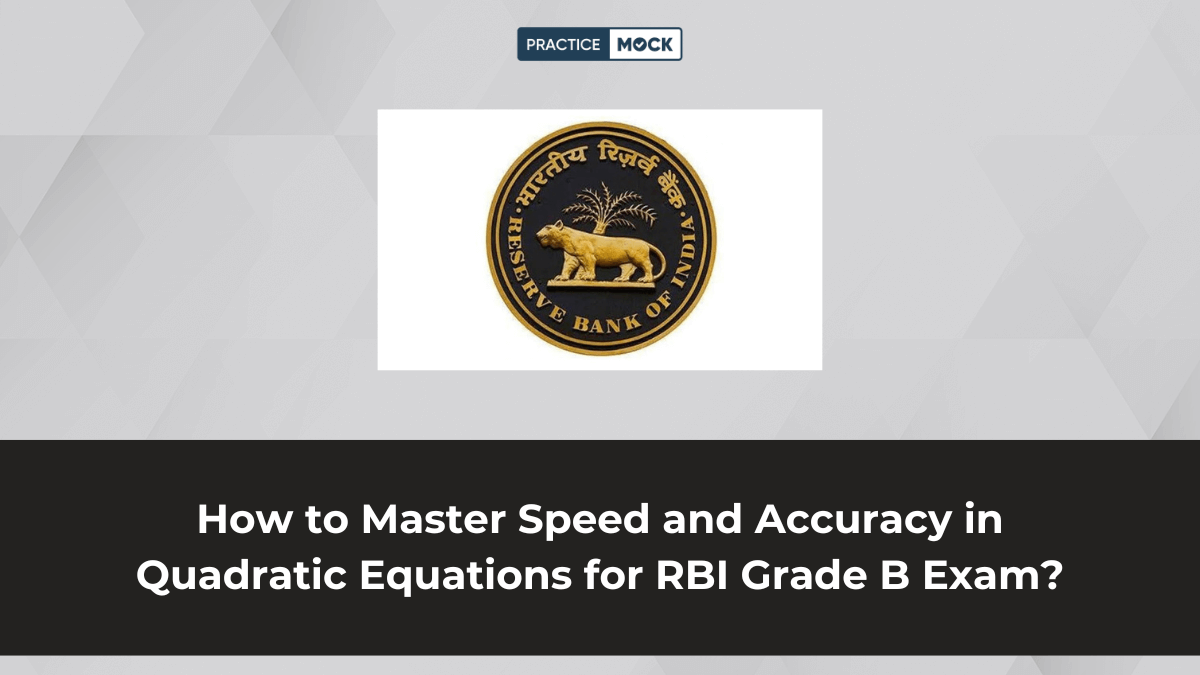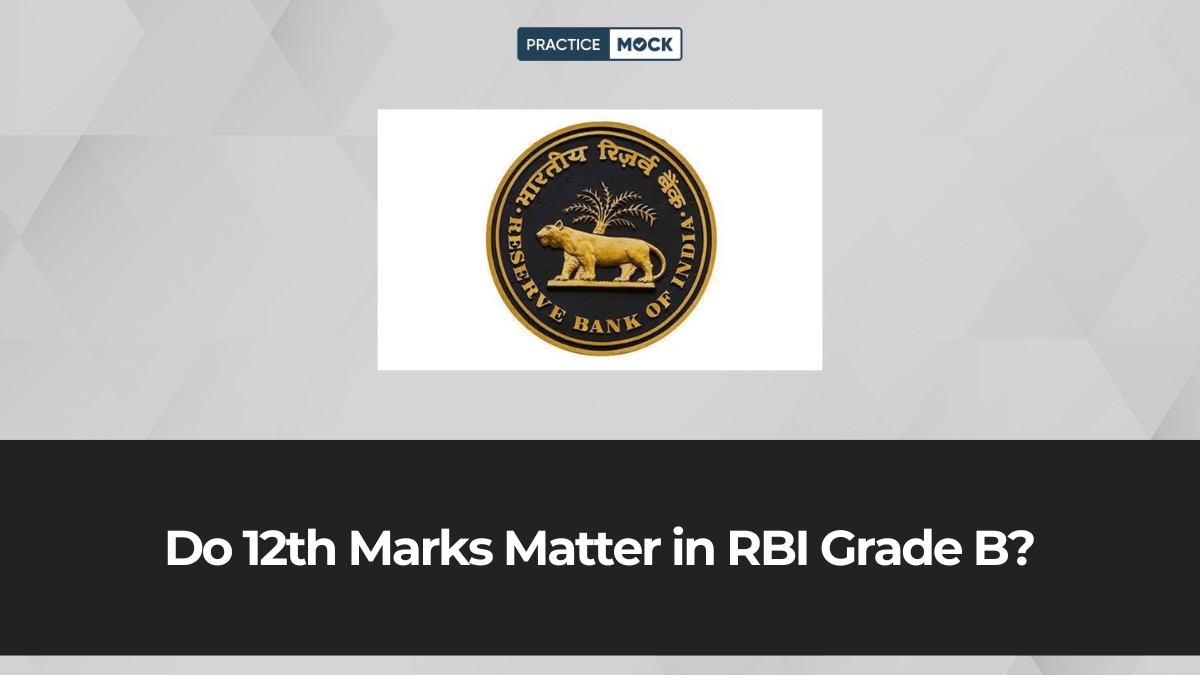How to Master Speed and Accuracy in Quadratic Equations for RBI Grade B Exam?


Quadratic equations are an important topic in the Quantitative Aptitude section of the RBI Grade B Exam. It is part of the Phase 1 exam. This part holds considerable importance. You can generally expect around 2 to 3 questions from this topic. So, it’s essential to be well-versed in quadratic equations for scoring maximum marks in this section. In this article, we’ll discuss types of QEs and practical tips to master the speed and accuracy while solving them.
Types of Quadratic Equations
Quadratic equations can appear in different formats. So, it’s super-important to know the different types to solve them competently.
Here are the essential types of questions:
- Basic Quadratic Equations: Solve equations like ax2+bx+c=0ax^2 + bx + c = 0.
- Roots-based Questions: Identify roots or pairs of roots for given equations.
- Equation Comparison: Compare two or more equations to find relationships between variables.
- Column Matching: Match equations to their correct roots from given options.
Tips to Master Speed and Accuracy
Now that you know the types of questions, you need to start solving every type to master the art of answering them in a limited time. Here are a few points that you need to keep in mind and follow to achieve you goal:
- Practice regularly to get familiar with different types of questions.
- Learn to factor quickly for solving equations in less time.
- Focus on pattern recognition to identify common techniques.
- Do mental calculations whenever possible to save time.
- Review past papers to understand the question patterns.
- Use approximation techniques to quickly narrow down answers.
Mastering these techniques will significantly enhance your speed and accuracy in solving quadratic equations, making you better prepared for the exam.
Importance of Knowing All Types of Questions
Understanding the different types of quadratic equations and practicing them regularly will help you solve questions efficiently under exam conditions. Quadratic equations can be tricky, so familiarity with all the patterns and techniques is essential for tackling them quickly.
Here are 5 important question types with answers/solutions:
Question 1: In the questions, two equations I and II are given. You have to solve both equations to establish the correct relation between x and y and choose the correct option.
I.) 2x2 + 5x – 12 = 0
II.) 3y(y + 1) = 20(y – 1)
A) x > y
B) x < y
C) x = y or the relationship cannot be established
D) x ≥ y
E) x ≤ y
Question 2: Given below are three equations, I, II, and III, along with 3 pairs of roots. You have to solve the three equations and find which of the following equations (s) is/are provided with the correct pair of roots.
| Equation | Roots |
| I. 3x2 – x/2 – 35/2 = 0 | -7/3 and 5 |
| II. 2x2 – x = 21 | 7/2 and -3 |
| III. 16x – 3x2 + 12 = 0 | -2/3 and 6 |
A) Only I
B) Only III
C) Only I and III
D) Only II and III
E) Only II
Question 3: Given below are three equations I, II and III along with 3 pairs of roots. You have to solve the three equations and find which of the following equation(s) is/are provided with correct pair of roots.
| Equation | Roots |
| I. -2y2 + 9y + 18 = 0 | -3/2 and 6 |
| II. y2 – 5y = √1296 | -4 and 8 |
| III. 3y2 + 19y + 28 = 0 | -7/3 and 4 |
A) Only II
B) Only I and III
C) Only I
D) Only III
E) None of these
Question 4: Given below are two columns, i.e., column I and II. Column I contains the quadratic equation,s while Column II contains the roots of that equation, but not necessarily in the same order. You are required to match the quadratic equations given in column I with their respective roots given in column II and choose the correct option.
| Column I | Column II |
| 1. 3x2 – 13x – 10 = 0 | A. 3/2 and -8/3 |
| 2. 6y2 + 7y – 24 = 0 | B. -2/3 and 5 |
| 3. 3x(x + 3) = 6(11 – 3x) | C. 2 and -11 |
A) 1 – B, 2 – C, 3 – A
B) 1 – C, 2 – A, 3 – B
C) 1 – A, 2 – C, 3 – B
D) 1 – B, 2 – A, 3 – C
E) 1 – A, 2 – B, 3 – C
Question 5: In the questions, two equations, I and I,I are given. You have to solve both equations to establish the correct relation between x and y and choose the correct option.
I.) 4x + 19 = {11(x + 4)(x – 1) + 268}/(3x – 7)
II.) y2 + 324 = 36y
A) x > y
B) x < y
C) x = y or the relationship cannot be established
D) x ≥ y
E) x ≤ y
प्रश्न 1: None
A) x > y
B) x < y
C) x = y or the relationship cannot be established
D) x ≥ y
E) x ≤ y
प्रश्न 2: None
A) Only I
B) Only III
C) Only I and III
D) Only II and III
E) Only II
प्रश्न 3: None
A) Only II
B) Only I and III
C) Only I
D) Only III
E) None of these
प्रश्न 4: None
A) 1 – B, 2 – C, 3 – A
B) 1 – C, 2 – A, 3 – B
C) 1 – A, 2 – C, 3 – B
D) 1 – B, 2 – A, 3 – C
E) 1 – A, 2 – B, 3 – C
प्रश्न 5: None
A) x > y
B) x < y
C) x = y or the relationship cannot be established
D) x ≥ y
E) x ≤ y
ANSWER KEYS and SOLUTIONS:
| 1) – B) | 2) – D) | 3) – C) | 4) – D) | 5) – C) |
Solution 1: B)
From I:
2x2 + 5x – 12 = 0
2x2 + 8x – 3x – 12 = 0
2x(x + 4) – 3(x + 4) = 0
(2x – 3)(x + 4) = 0
x = 3/2 or -4
From II:
3y(y + 1) = 20(y – 1)
3y2 + 3y = 20y – 20
3y2 – 17y + 20 = 0
3y2 – 12y – 5y + 20 = 0
3y(y – 4) – 5(y – 4) = 0
(3y – 5) (y – 4) = 0
y = 5/3 or 4
| X | Relation | Y |
| 3/2 | < | 5/3 |
| 3/2 | < | 4 |
| -4 | < | 5/3 |
| -4 | < | 4 |
So, x < y
Hence, option b.
Solution 2: D)
From I:
3x2 – x/2 – 35/2 = 0
6x2 – x – 35 = 0
6x2 – 15x + 14x – 35 = 0
6x(x – 5/2) + 14(x – 5/2) = 0
(6x + 14) (x – 5/2) = 0
x = -7/3 or 5/2
Only one of the roots satisfies, hence equation I is not provided with appropriate roots.
From II:
2x2 – x = 21
2x2 – x – 21 = 0
2x2 – 7x + 6x – 21 = 0
2x(x – 7/2) + 6(x – 7/2) = 0
(2x + 6)(x – 7/2) = 0
x = -3 or 7/2
Both the roots satisfy, hence equation II is provided with appropriate roots.
From III:
16x – 3x2 + 12 = 0
-3x2 + 18x – 2x + 12 = 0
-3x(x – 6) – 2(x – 6) = 0
(-3x – 2) (x – 6) = 0
x = -2/3 or 6
Both the roots satisfy, hence equation III is provided with appropriate roots.
Hence, option d.
Solution 3: C)
From I:
-2y2 + 9y + 18 = 0
-2y2 + 12y – 3y + 18 = 0
-2y(y – 6) -3(y – 6) = 0
(-2y – 3) (y – 6) = 0
y = -3/2 or 6
Both the roots satisfy, hence equation I is provided with appropriate roots.
From II:
y2 – 5y = √1296
y2 – 5y = 36
y2 – 9y + 4y – 36 = 0
y(y – 9) + 4(y – 9) = 0
(y + 4)(y – 9) = 0
y = -4 or 9
Only one of the roots satisfies, hence equation II is not provided with appropriate roots.
From III:
3y2 + 19y + 28 = 0
3y2 + 12y + 7y + 28 = 0
3y(y + 4) + 7(y + 4) = 0
(3y + 7)(y + 4) = 0
y = -7/3 or -4
Only one of the given roots satisfies, hence equation III is not provided with appropriate roots.
Hence, option c.
Solution 4: D)
Equation 1:
3x2 – 13x – 10 = 0
3x2 – 15x + 2x – 10 = 0
3x(x – 5) + 2(x – 5) = 0
(3x + 2)(x – 5) = 0
x = -2/3 or 5
Equation 2:
6y2 + 7y – 24 = 0
6y2 + 16y – 9y – 24 = 0
6y(y + 8/3) – 9(y + 8/3) = 0
(6y – 9) (y + 8/3) = 0
y = 3/2 or -8/3
Equation 3:
3x(x + 3) = 6(11 – 3x)
3x2 + 9x = 66 – 18x
3x2 + 27x – 66 = 0
3x2 + 33x – 6x – 66 = 0
3x(x + 11) -6(x + 11) = 0
(3x – 6) (x + 11) = 0
x = 2 or -11
Hence, option d.
Solution 5: C)
From I:
4x + 19 = {11(x + 4)(x – 1) + 268}/(3x – 7)
Or, (4x + 19)(3x – 7) = 11(x2 + 4x – x – 4) + 268
Or, 12x2 + 57x – 28x – 133 = 11x2 + 33x – 44 + 268
Or, x2 – 4x – 357 = 0
Or, x2 – 21x + 17x – 357 = 0
Or, x(x – 21) + 17(x – 21) = 0
Or, x = 21, -17
From II:
y2 + 324 = 36y
Or, y2 – 36y + 324 = 0
Or, y2 – 18y – 18y + 324 = 0
Or, y(y – 18) – 18(y – 18) = 0
Or, (y – 18)(y – 18) = 0
Or, y = 18
| X | Relation | Y |
| 21 | > | 18 |
| -17 | < | 18 |
So, no relation can be established between ‘x’ and ‘y’.
Hence, option c.
Conclusion
Candidates must regularly practice all types of questions to increase their speed in answering quadratic equation questions. The most important of these are multiple equations, roots, and relationships. Candidates should continue to work on making quick calculations. Additionally, they need to focus fully on factoring techniques and understand the underlying patterns thoroughly. Through consistent practice, they can improve their speed and accuracy, and prepare themselves completely for the RBI Grade B Exam.
Recent Posts
150+ Arithmetic Questions for RRB PO Based On Previous Year Papers
In this article we are providing the 150+ Arithmetic Questions for RRB PO Based On…
Do RBI Grade B Officers Get a Pension? Know Before You Start Preparing
Before preparing for RBI Grade B, understand the pension policy, long-term benefits, and how it…
RRB ALP Eligibility Criteria 2025: Qualification, Age Limit, and Other Details
In this blog, we have provided the RRB ALP Eligibility Criteria 2025 which includes Qualification,…
RBI Grade B Latest Updates, Everything You Should Know
Get the latest RBI Grade B updates, including notification dates, eligibility, syllabus, and exam pattern.…
BOB Office Assistant Syllabus 2025, With Latest Exam Pattern
Bank of Baroda Office Assistant syllabus 2025 covers the latest exam pattern for the aspiring…
RRB Group D Exam Date 2025, Check Railways CBT Exam Expected Dates
The RRB will release the RRB Group D Exam Date 2025. In this blog, we…



